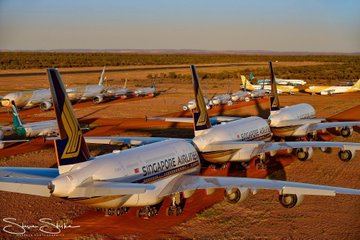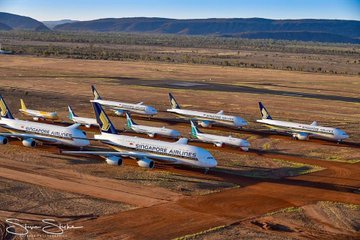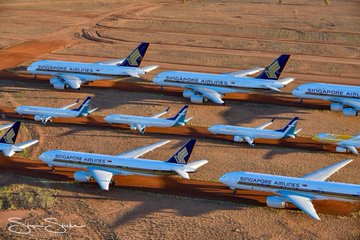Chilling Images: Singapore Airlines’ A380s Stored In The Desert
An Alice Springs photographer has captured images of parked jets at the Asia Pacific Aircraft Storage facility in Alice Springs, Australia. The global airline crisis has proved a boon for the desert facility. In a matter of months, it has seen the planes parked there increase from eight to 24, with more expected to arrive soon.

A good spot to store a clutch of A380s
Asia Pacific Aircraft Storage (APAS) has been in business for a decade. The dry desert climate and ample space around Alice Springs Airport made it a logical spot for an aircraft storage facility. It doesn’t hurt that a nearby top-secret US eavesdropping outpost saw the airport upgraded to handle the largest planes.
That’s what the airport had to do two weeks ago when four Singapore Airlines A380s landed at Alice Springs and taxied over to the APAS facility. Singapore Airlines is proving a good customer for APAS. Besides the A380s, the airline has three Boeing 777s parked there. This is in addition to a pair of NokScoot Boeing 777s and four Scoot A320 aircraft. The Scoot brand is a low-cost subsidiary of Singapore Airlines.
Advertisement:
Featured Video:
Last year, as the Boeing 737 MAX grounding began to bite, another Singapore Airlines subsidiary, Silk Air, sent eight 737 MAX 8s to APAS. They remain at the facility. Rounding out the customers at Alice Springs is Fiji Airways with a pair of 737 MAX 8s and a clutch of Alliance Airlines Fokker jets. Alliance Airlines does some regular passenger transport and resources charter flying in Australia. It is the largest operator of Fokker jets in the world.
Advertisement:
A380s strike a pose in the desert dust
Alice Springs photographer Steve Striker has had some of his photos of the parked aircraft published on the Air Plus News Twitter feed. They show the parked aircraft off to the side of one of Alice Springs Airport’s two runways. Parking bays run off access roads. The big A380s are particularly striking against the red dust desert landscapes.
Impressionnant ! L’aéroport d’Alice Springs, dans le désert australien sert de lieu de stockage longue durée pour de nombreux avions de Singapore Airlines dont des A380.
Steve Strike
280 people are talking about this
“It’s low humidity, it’s low rainfall, it’s the ideal climate for asset preservation,” APAS owner and manager Tom Vincent told the Financial Times last year.
The bulk of APAS’s customers come from the Asia Pacific. While Alice Springs is remote, it’s relatively accessible for airlines in that region. In the next 20 years, Asia Pacific is expected to account for 40% of the global aviation market, a handy market share into which APAS can tap.
All the aircraft are expected to fly again
Mr Vincent notes his facility isn’t a graveyard; it is a storage facility. His employees induct the planes into storage then preserve and maintain them. While a large amount of work will have to be done on each plane to get them flying again, the expectation is that each plane at Alice Springs will fly again.
The storage facility is being expanded to handle up to 100 aircraft. The owners of the facility expect business to be brisk as airlines continue to look for places to park their surplus aircraft. Many analysts predict it will take some years for airline traffic to return to pre-pandemic levels. This isn’t good news for the likes of Singapore Airlines, but it does suggest a bright future for storage facilities such as the one in Alice Springs.






Comments